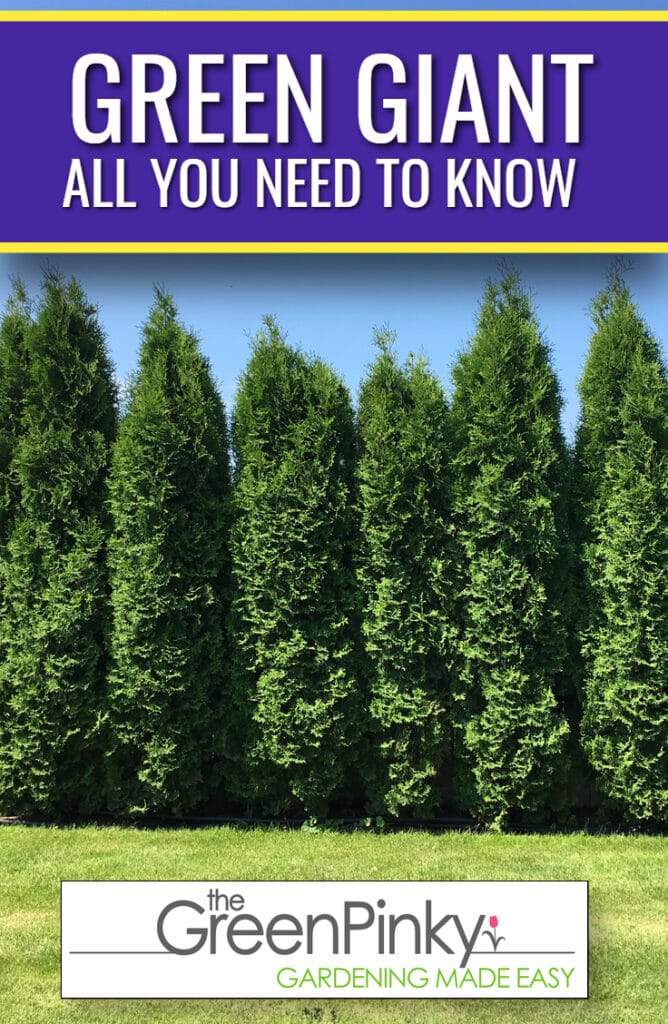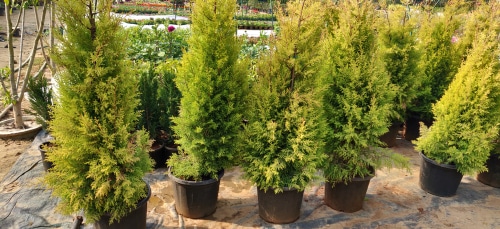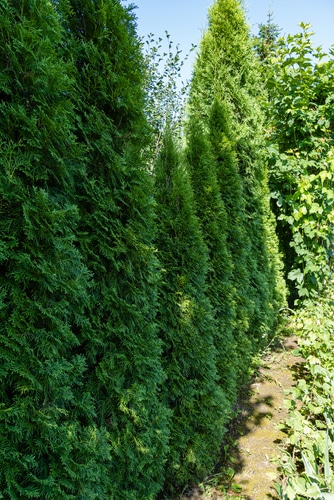Emerald Green Cedar Trees (Thuja occidentalis ‘Smaragd’) are an evergreen conifer that is a type of arborvitae, also referred to as American Arborvitae ‘Smaragd’. They provide a striking gardening or landscaping tree addition. Once a suitable area is chosen for its growth, each tree will give beauty to the garden. In landscaping, they are excellent used as privacy hedges or as single focus specimens in the garden.
Keep reading to learn everything you need to know about planting and taking care of emerald cedar arborvitae.
Make sure to also check out how to care for Green Giant arborvitae, another very popular species.

General Growing Information
The decorative fan-shaped leaves of the Emerald Cedar is popular with homeowners and landscape architects. These arborvitaes have a narrow pyramidal shape conducive to creating privacy hedges and as screening trees.
They thrive in plant hardiness zones 2-7. The trees grow 15 feet tall by 3 to 4 feet wide. The plants develop cones around 6 years of age.
In the spring, the Thuja plants’ leaves offer an aromatic scent. Their pyramidal form and bright yellow-green to emerald green foliage pops in the snow. As they age, their green color will continue to deepen.
They can be planted in containers in smaller garden areas, as single specimens for focal interest, or lined up in a row for a privacy hedge.
Planting Guide
It’s a good idea to test the soil in the area you plan to plant. Then, amend the soil as necessary. The landscaping area for these plants requires loose soils that are high in nutrients.
Make sure to loosen the root ball a bit before planting and do not bury it too deep. The hole should be the same depth as the root ball and twice the width.
If planting multiple trees, be prepared to plant your trees quickly as the roots can become dry and damaged when exposed too long to wind and air. When planting a cedar hedge, first dig all of your holes, making sure to follow the rule of thumb of digging as deep as the rootball and twice the width. Be prepared to plant all the Emerald Cedar trees all at the same time.
When planting the Thuja trees, make sure they are standing upright, as a crooked hedge will detract from the desired landscaping aesthetic. You can use t-posts and strong wires to hold them upright as the plants begin settling in their roots.

Often, landscaping trees will have wire or burlap wrapped around the root ball. Remove this to prevent the problem of your Emerald Cedar trees becoming rootbound after planting.
Thuja occidentalis ‘Smargagd’ are readily available at many garden centers. They can tolerate almost any soil conditions, but prefer nutrient-rich soil and require good drainage. However, Thujas are sensitive to windy and dry conditions.
Ensure Proper Spacing
With proper care, these trees grow at a rate of 8-12 inches per year. For proper Emerald Green Cedar spacing for privacy hedges, use 18-24 inch between plants. For focal points, plant Emerald Cedars a minimum of 4 feet away from a wood fence, other trees, or barriers.
Thuja Occidentalis Maintenance Guide
Sun Requirements
Emerald Cedar Arborvitae prefer full sun and tolerate part shade. However, for the healthiest foliage, plant them in full sun. In very hot climates, provide a bit of afternoon protection if possible.
Water Deeply
Water moderately in well-drained soil. A soaker hose around the tree planting will help keep these conifers well-watered, especially throughout times of drought and as they become established plants.
Wood chips act as effective mulch for water retention and to protect the roots of the young trees. As the trees grow and drop brown needles, the leaf material provides good mulch and nutrients to the plants.
When establishing the arborvitae, make sure to water them deeply 3 to 5 times per week and do not let the soil dry out in between waterings. When trees are dormant, give them a deep watering once per month.

Prune Once Per Year
To maintain the beauty and purpose of your thuja, you will need to put some effort into maintaining its shape.
Prune Emerald Cedars once per year. This can be done in early spring. Make sure to sanitize pruners in between cuts to prevent the spread of disease and pests. When growing emerald cedars as hedges, prune them in late summer to your desired shape.
When pruning Thujas, be careful not to cut into old bark. This will promote new growth where it is not wanted. Be conservative in your plant pruning as the underpart of the plant is bare and will look scraggly if you expose too much of the brown part of the plant. For a privacy hedge, tip the tops for the standard landscaping appearance.
If the arborvitae seem not to be as lush as you had hoped, and you have not over-pruned them, try adding an application of 30-10-10 fertilizer, taking care to follow all instructions.
Potential Arborvitae Problems
Bagworms, spider mites, and mealybugs can cause damage to Emerald Cedar trees. Check for brown leaves periodically. If there is damage, look for the listed pests. An application of insecticide as necessary should alleviate these pests. Search for these pests, especially when temperatures are warmer.
Watch for leaf blight, leaf spot, canker, and leaf miner damage as well. Fungicidal applications may be necessary to keep your cedar trees in top condition. In winter, ice and snow can cause damage to the branches of these arborvitae trees. Pruning out the damaged limbs will keep the plantings looking good.

Great for Low Maintenance Landscaping
Emerald Cedar trees make a practical landscaping addition and property screen or privacy hedge. They provide year-round interest and are a low-fuss, attractive tree.
Landscaping the garden with Thuja Occidentalis creates attractive privacy hedges and focal points in the garden. With proper planting and minimal maintenance, the look of the garden will be elevated substantially with these plants.


Great info! I was wondering, should you fertilize these trees when planting?
Yes, fertilize to encourage growth after transplanting. Consider diluting your fertilizer a little more than called for.
I purchased several trees 2 months ago and know the trees have turned brown.
Is there anything I can do to bring them back?
All Brown? Entire Tree. 1) read up on planting a tree and in particular Emerald Cedars 2) Plenty of water for a couple of years 3) Location – preference is not too windy or dry and break from hot afternoon sun.
I have two trees that turned brown and I believe its due to a lack of sun. The neighbors house extends further back than mine and blocks the sun. So sad…
Thanks for the great info! Which would you say provide for a better privacy hedge – emerald or brendan?
Can you plant emerald cedar early September /end August?
Planted a row of these (25) and they are doing great. Just got a wet snow storm that bent them almost to the ground with this heavy snow overnight, straighten them in the morning will they be damaged permanently ?